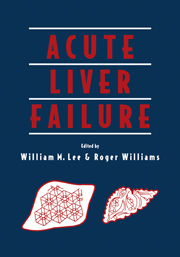Book contents
- Frontmatter
- Contents
- Preface
- Foreword
- Acknowledgments
- Contributors
- Part One Clinical Syndrome and Etiology
- Part Two Mechanisms of Disease and Multisystem Involvement
- Part Three Intensive Care Management
- Part Four Transplantation
- 14 Prognosis and consideration of transplantation
- 15 Liver transplantation in patients with acute liver failure: the European experience
- 16 Transplantation for acute liver failure: the American experience
- 17 Auxiliary liver transplantation
- Part Five Artificial and Bioartificial Liver Devices
- Part Six Other Applications
- Index
- Plate section
14 - Prognosis and consideration of transplantation
from Part Four - Transplantation
Published online by Cambridge University Press: 20 May 2010
- Frontmatter
- Contents
- Preface
- Foreword
- Acknowledgments
- Contributors
- Part One Clinical Syndrome and Etiology
- Part Two Mechanisms of Disease and Multisystem Involvement
- Part Three Intensive Care Management
- Part Four Transplantation
- 14 Prognosis and consideration of transplantation
- 15 Liver transplantation in patients with acute liver failure: the European experience
- 16 Transplantation for acute liver failure: the American experience
- 17 Auxiliary liver transplantation
- Part Five Artificial and Bioartificial Liver Devices
- Part Six Other Applications
- Index
- Plate section
Summary
INTRODUCTION
Liver transplantation is an important treatment option in the management of severe cases of acute liver failure (ALF). The process of selecting appropriate patients for transplantation rather than relying on intensive conservative medical therapy remains problematic (Van Thiel 1993). Before reaching a decision in favor of surgical intervention, clinicians have to be able to identify those patients in whom the prognosis is otherwise poor and in whom the likely outcome will be considerably improved by transplantation. The practical importance of accurate determination of prognosis has stimulated several centers to examine systematically their outcomes experience in patients with ALF (Iwatsuki et al. 1985; Emond et al. 1989). Several different prognostic variables have been derived from these studies (Christensen et al. 1984; Bernuau et al. 1986; O'Grady et al. 1989). However, paradoxically, the sickest patients who carry the worst prognosis, are also those in whom the complications of the liver failure render them least likely to survive a transplant.
In this chapter, we will review the clinical and laboratory characteristics which are associated with a poor prognosis in ALF and which accordingly serve as a useful basis for selecting candidates for transplantation. Thereafter, we will consider the equally difficult issue of identifying those clinical features present before transplantation, which are associated with unfavorable post-transplant outcomes. These features, if validated, could serve as relative contraindications to proceeding with a liver graft.
PROGNOSIS OF LIVER FAILURE
A thorough understanding of the natural history and prognosis of the different clinical and etiological variants of acute liver failure is mandatory if an informed decision on the likelihood of spontaneous recovery and survival, with conservative management, is to be made.
- Type
- Chapter
- Information
- Acute Liver Failure , pp. 173 - 185Publisher: Cambridge University PressPrint publication year: 1996



